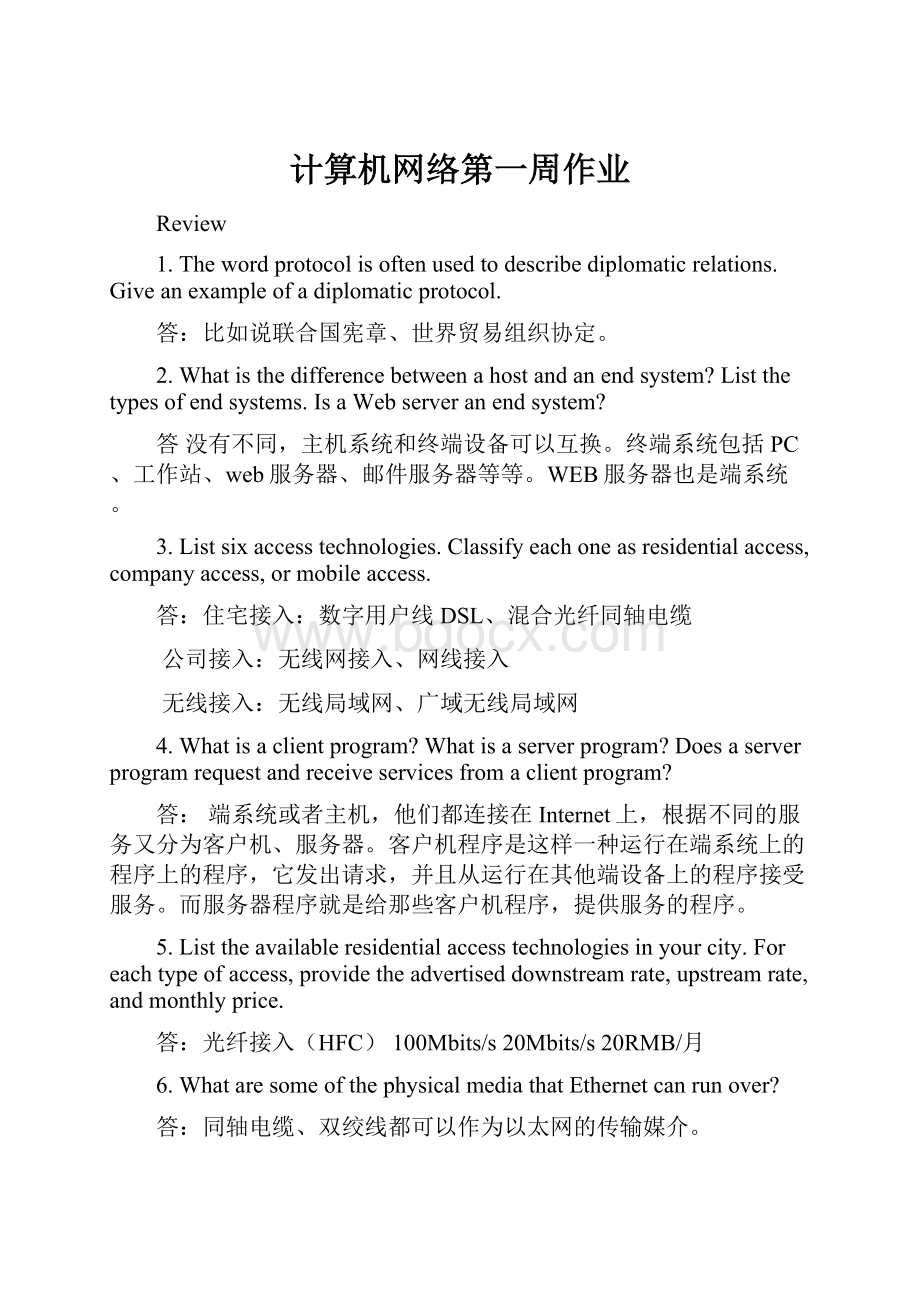计算机网络第一周作业.docx
《计算机网络第一周作业.docx》由会员分享,可在线阅读,更多相关《计算机网络第一周作业.docx(13页珍藏版)》请在冰豆网上搜索。

计算机网络第一周作业
Review
1.Thewordprotocolisoftenusedtodescribediplomaticrelations.Giveanexampleofadiplomaticprotocol.
答:
比如说联合国宪章、世界贸易组织协定。
2.Whatisthedifferencebetweenahostandanendsystem?
Listthetypesofendsystems.IsaWebserveranendsystem?
答没有不同,主机系统和终端设备可以互换。
终端系统包括PC、工作站、web服务器、邮件服务器等等。
WEB服务器也是端系统。
3.Listsixaccesstechnologies.Classifyeachoneasresidentialaccess,companyaccess,ormobileaccess.
答:
住宅接入:
数字用户线DSL、混合光纤同轴电缆
公司接入:
无线网接入、网线接入
无线接入:
无线局域网、广域无线局域网
4.Whatisaclientprogram?
Whatisaserverprogram?
Doesaserverprogramrequestandreceiveservicesfromaclientprogram?
答:
端系统或者主机,他们都连接在Internet上,根据不同的服务又分为客户机、服务器。
客户机程序是这样一种运行在端系统上的程序上的程序,它发出请求,并且从运行在其他端设备上的程序接受服务。
而服务器程序就是给那些客户机程序,提供服务的程序。
5.Listtheavailableresidentialaccesstechnologiesinyourcity.Foreachtypeofaccess,providetheadvertiseddownstreamrate,upstreamrate,andmonthlyprice.
答:
光纤接入(HFC)100Mbits/s20Mbits/s20RMB/月
6.WhataresomeofthephysicalmediathatEthernetcanrunover?
答:
同轴电缆、双绞线都可以作为以太网的传输媒介。
8.DescribethemostpopularwirelessInternetaccesstechnologiestoday.Compareandcontrastthem.
答:
主要有两种接入方式:
*IEEE802.11技术无线LAN接入,用户距离接入点的几十米的范围内。
通过连接到有线网的基站间接将用户连接到有线网上。
*3G与LET网络。
在这些系统中通过用于拨打电话的网络硬件设施,为在基站范围内的用户提供无线网络接入。
9.Dial-upmodems,HFC,andDSLareallusedforresidentialaccess.Foreachoftheseaccesstechnologies,providearangeoftransmissionratesandcommentonwhetherthetransmissionrateissharedordedicated.
答:
拨号调制解调器的速率通常是56K左右,这个是很早的技术与速率,带宽是独占的。
DSL的速率是上下行不对称的,根据费用不同分为512K、1M、2M三种,还有不限速的上网,带宽是专用的。
HFC的速率优于10M、100M、1G、10G的速率,带宽是共享的。
10.WhatisthetransmissionrateofEthernetLANs?
…….
答:
以太网拥有10Mbps、100Mbps、1Gbps和10Gbps几种。
不能,带宽是在该线路上的用户共享。
11.Supposethereisexactlyonepacketswitchbetweenasendinghostandareceivinghost……
答:
延时为两段延时之和,L/R1+L/R2。
14.Supposeuserssharea2Mbpslink.Alsosupposeeachuserrequires1Mbpswhentransmitting。
。
。
答a:
2个,一人分1Mbps的专有带宽;b:
当有两个人或一个人使用网络时,最高带宽占用为2Mbps,所以绝对不会有排队延时出现。
但是,当3个及以上人使用时,最高需要3Mbps,但是最高提供2Mbps,所以会出现延时;c:
0.2;d:
3人同时传输的概率是0.008;所以时间增长的时间出现也是0.008
15.Whyisitsaidthatpacketswitchingemploysstatisticalmultiplexing?
.......
答:
统计复用是对通信链路的一种高效的利用方法。
所有链路上被按需分配,是一种按照概率统计的方法假设在一个时间段内,只有某几个用户在使用链路。
TDM中的统计复用是对所有用户的事先分配了链路上的所有资源,传输速率是恒定的。
按照预定分配,标记适合于处理恒定传输速率的业务,比如电话电路。
而分组交换是按需分配,对链路的利用效率更高,资源共享,速率不恒定。
17.Considersendingapacketfromasourcehosttoadestinationhostoverafixedroute.Listthedelaycomponentsintheend-to-enddelay.Whichofthesedelaysareconstantandwhicharevariable?
答:
节点总时延由处理时延、传输时延、传播时延和排队时延组成。
所有这些时延除了排队时延都是固定的。
18.SupposeHostAwantstosendalargefiletoHostB.ThepathfromHostAtoHostBhasthreelinks,ofratesR1=250kbps,R2=500kbps,andR3=1Mbps.
答:
a:
R=min{R1,R2,R3}=min{500kbp,2Mbps,1Mbps}=500kbps
b:
T=4000KB/(500Kbps/8)=64s
c:
R=min{R1,R2,R3}=min{500kbps,100kbps,1Mbps}=100Kpbs;
T=4000KB/(100Kbps/8)=320s
20.Howlongdoesittakeapacketoflength1,000bytestopropagateoveralinkofdistance2,500km,propagationspeed2.5·108m/s...
答:
10^-5s;L/s;否;否
21.SupposeendsystemAwantstosendalargefiletoendsystemB.Ataveryhighlevel,describehowendsystemAcreatespacketsfromthefile.Whenoneofthesepacketsarrivestoapacketswitch,whatinformationinthepacketdoestheswitchusetodeterminethelinkontowhichthepacketisforwarded?
WhyispacketswitchingintheInternetanalogoustodrivingfromonecitytoanotherandaskingdirectionsalongtheway?
答:
将文件拆成多个小块。
并为每个块添加标头,从而从文件生成多个数据包。
每个数据包中的标头包括目的地址的IP。
分组交换机使用该IP地址确定输出链路。
在给定数据包的目的地址情况下,询问哪条路要类似于这个的数据包,询问它应该转发哪个输出链路。
22.WhichlayersintheInternetprotocolstackdoesarouterprocess?
Whichlayersdoesalink-layerswitchprocess?
Whichlayersdoesahostprocess?
答:
路由器处理第1层到第3层。
链路层交换机处理1到2.主机处理所有5各层。
23.Listfivetasksthatalayercanperform.Isitpossiblethatone(ormore)ofthesetaskscouldbeperformedbytwo(ormore)layers?
答:
五个通用任务是错误控制、流控制、分段和重组、多路复用和连接设置。
这些任务可以在不同的层重复。
25.WhatarethefivelayersintheInternetprotocolstack?
Whataretheprincipalresponsibilitiesofeachoftheselayers?
答:
应用层:
应用层是网络应用层协议存留的地方;运输层:
因特网的运输层在应用程序端点之间传输报文;网络层:
因特网的网络层负责将成为数据报的网络层分组从一台主机移动到另一台主机;链路层:
因特网的网络层通过源和目的地之间的一系列路由器路由数据报;物理层:
将帧的一个个比特从一个结点转移到另一个结点。
Problem
1Considerthecircuit-switchednetworkinFigure1.8.Recallthattherearencircuitsoneachlink
答a:
4n;b:
2n。
2.Consideranapplicationthattransmitsdataatasteadyrate(forexample,thesendergeneratesanN-bitunitofdataeveryktimeunits,wherekissmallandfixed).Also,whensuchanapplicationstarts,itwillcontinuerunningforarelativelylongperiodoftime.Answerthefollowingquestions,brieflyjustifyingyouranswer:
答:
a:
电路交换非常适合这个应用,因为传输速率已知并且会话为长会话,不会造成带宽的大量浪费。
b:
在最坏的情况下,所有应用程序都通过一条链路传输数据,因为还未达到链路最大带宽所以不会发生拥堵,所以网络不需要拥塞控制机制。
3.Reviewthecar-caravananalogyinSection1.4.Assumeapropagationspeedof100km/hour.a.Supposethecaravantravels150km,beginninginfrontofonetollbooth,passingthroughasecondtollbooth,andfinishingjustafterathirdtollbooth.Whatistheend-to-enddelay?
b.Repeat(a),nowassumingthatthereareeightcarsinthecaravaninsteadoften.
答:
2min+60min+2min+60min=124min;1.4min+60min+1.4min+60min=122.8min
4.(未留)
5.Thiselementaryproblembeginstoexplorepropagationdelayandtransmissiondelay,twocentralconceptsindatanetworking.Considertwohosts,AandB,connectedbyasinglelinkofrateRbps.Supposethatthetwohostsareseparatedbymmeters,andsupposethepropagationspeedalongthelinkissmeters/sec.HostAistosendapacketofsizeLbitstoHostB.
答:
dprop=m/s;dtrans=L/R;end-to-enddelay=m/s+L/R;刚刚离开hostA;还在链路上,未到达hostB;已经到达了hostB;m=L/R*s=892.86km
6.Supposeuserssharea1Mbpslink.Alsosupposeeachuserrequires100kbpswhentransmitting,buteachusertransmitsonly10percentofthetime.(SeethediscussionofpacketswitchingversuscircuitswitchinginSection1.3.)
答:
a:
1Mbps/100kbps=10;b:
p=0.1;c:
(C40,n)\*(p)\^n\*(1-p)\^(40-n);d:
P(11人或以上人使用)=
7.Inthisproblem,weconsidersendingreal-timevoicefromHostAtoHostBoverapacket-switchednetwork(VoIP).HostAconvertsanalogvoicetoadigital64kbpsbitstreamonthefly.HostAthengroupsthebitsinto48-bytepackets.ThereisonelinkbetweenHostsAandB;itstransmissionrateis1Mbpsanditspropagationdelayis2msec.AssoonasHostAgathersapacket,itsendsittoHostB.AssoonasHostBreceivesanentirepacket,itconvertsthepacket’sbitstoananalogsignal.Howmuchtimeelapsesfromthetimeabitiscreated(fromtheoriginalanalogsignalatHostA)untilthebitisdecoded(aspartoftheanalogsignalatHostB)?
答:
考虑包中的第一个bit,在这个比特被传输之前,包中的所有比特都必须被生成。
这需要
传输数据包所需的时间是
传播延迟为2msec。
解码之前的延迟是
7msec+896μsec+2msec=9.896msec
因此延迟为9.896msec。
ConsiderthediscussioninSection1.3ofpacketswitchingversuscircuitswitchinginwhichanexampleisprovidedwitha1Mbpslink.Usersaregeneratingdataatarateof100kbpswhenbusy,butarebusygeneratingdataonlywithprobabilityp=0.1.Supposethatthe1Mbpslinkisreplacedbya1Gbpslink.
a.WhatisN,themaximumnumberofusersthatcanbesupportedsimultaneouslyundercircuitswitching?
b.NowconsiderpacketswitchingandauserpopulationofMusers.Giveaformula(intermsofp,M,N)fortheprobabilitythatmorethanNusersaresendingdata.
答:
a).10000b).Cnm*P^n*(1-q)^(m-n))
9.Intheaboveproblem,supposeR1=R2=R3=Randdproc=0.Furthersupposethepacketswitchdoesnotstore-and-forwardpacketsbutinsteadimmediatelytransmitseachbititreceivesbeforewaitingfortheentirepackettoarrive.Whatistheend-to-enddelay?
答:
由于bits是立即传输的,包交换不引入任何延迟;因此不引入传输延迟。
D(end-end)=L/R+d1/s1+d2/s2
->8+24+12=44msec。
10.Considerthequeuingdelayinrouterbuffer(precedinganoutboundlink).SupposeallpacketsareLbits,thetransmissionrateisRbps,andthatNpacketssimultaneouslyarriveatthebuffereveryLN/Rseconds.Findtheaveragequeuingdelayofapacket.(Hint:
Thequeuingdelayforthefirstpacketiszero;forthesecondpacketL/R;forthethirdpacket2L/R.TheNthpackethasalreadybeentransmittedwhenthesecondbatchofpacketsarrives.)
答:
总延迟=(0+1+…+n-1)L/R
平均延迟=(n-1)L/2R
11.SupposeNpacketsarrivesimultaneouslytoalinkatwhichnopacketsarecurrentlybeingtransmittedorqueued.EachpacketisoflengthLandthelinkhastransmissionrateR.WhatistheaveragequeuingdelayfortheNpackets?
答(L/R+2L/R+.......+(N-1)L/R)/N=L/(RN)*(1+2+.....+(N-1))=L/(RN)*N(N-1)/2=LN(N-1)/(2RN)=(N-1)L/(2R)
12.ConsiderapacketoflengthLwhichbeginsatendsystemA,travelsoveronelinktoapacketswitch,andtravelsfromthepacketswitchoverasecondlinktoadestinationendsystem.Letdi,si,andRidenotethelength,propagationspeed,andthetransmissionrateoflinki,fori=1,2.Thepacketswitchdelayseachpacketbydproc.Assumingnoqueuingdelays,intermsofdi,si,Ri,(i=1,2),andL,whatisthetotalend-to-enddelayforthepacket?
答:
第一个端系统需要L/R1时间将数据包传输到第链路上,包花费d1/s1在一个链路上,交换机在接收到整个数据包后处理延迟为dproc,包交换机需要L/R2将数据包传输到第二个链路上;包花费d2/s2在第二个链路上传播,d(end-end)=L/R1+L/R2+d1/s1+d2/s2+dproc。
代入方程,得到8+8+16+4+1=37msec。
13.Considerthequeuingdelayinarouterbuffer.LetIdenotetrafficintensity;thatis,I=La/R.SupposethatthequeuingdelaytakestheformIL/R(1–I)forI<1.
a.PlotthetotaldelayasafunctionofL/R.
b.Provideaformulaforthetotaldelay,thatis,thequeuingdelayplusthe
答:
令x=L/R,Totaldelay=x/(1-ax)
Totaldelay=IL/R(1-I)+L/R=L/R(1-I);
14.a.GeneralizeEquation1.2inSection1.4.3forheterogeneousprocessingrates,transmissionrates,andpro